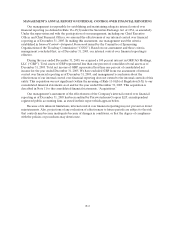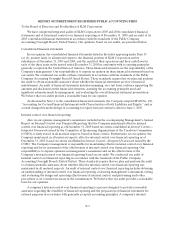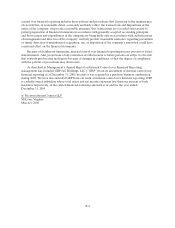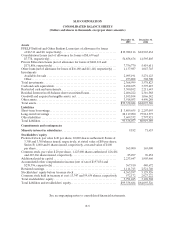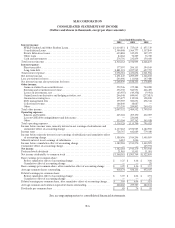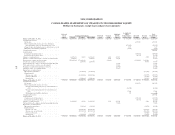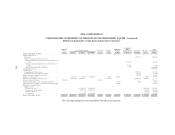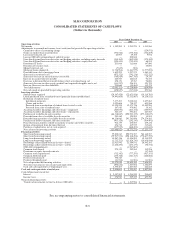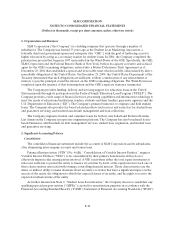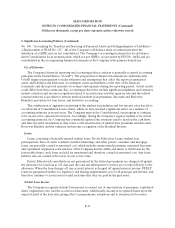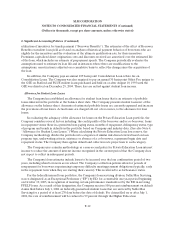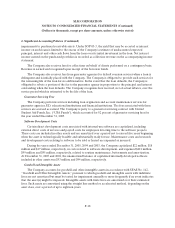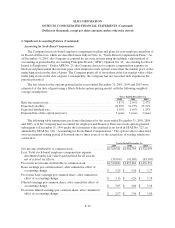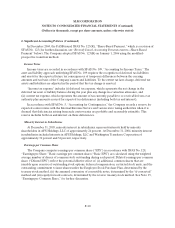Sallie Mae 2005 Annual Report Download - page 134
Download and view the complete annual report
Please find page 134 of the 2005 Sallie Mae annual report below. You can navigate through the pages in the report by either clicking on the pages listed below, or by using the keyword search tool below to find specific information within the annual report.SLM CORPORATION
NOTES TO CONSOLIDATED FINANCIAL STATEMENTS (Continued)
(Dollars in thousands, except per share amounts, unless otherwise stated)
F-12
2. Significant Accounting Policies (Continued)
utilization of incentives for timely payment (“Borrower Benefits”). The estimates of the effect of Borrower
Benefits on student loan yield are based on analyses of historical payment behavior of borrowers who are
eligible for the incentives and the evaluation of the ultimate qualification rate for these incentives.
Premiums, capitalized direct origination costs and discounts received are amortized over the estimated life
of the loan, which includes an estimate of prepayment speeds. The Company periodically evaluates the
assumptions used to estimate its loan life and in instances where there are modifications to the
assumptions, amortization is adjusted on a cumulative basis to reflect the change since the acquisition of
the loan.
In addition, the Company pays an annual 105 basis point Consolidation Loan rebate fee on
Consolidation Loans. The Company was also required to pay an annual 30 basis point Offset Fee unique to
the GSE on Stafford and PLUS student loans purchased and held on or after August 10, 1993 until the
GSE was dissolved on December 29, 2004. These fees are netted against student loan income.
Allowance for Student Loan Losses
The Company has established an allowance for student loan losses that is an estimate of probable
losses inherent in the portfolio at the balance sheet date. The Company presents student loans net of the
allowance on the balance sheet. Amounts of estimated probable losses are currently expensed and increase
the provisions of loan losses. Actual losses are charged off, net of recoveries, to the allowance for loan
losses.
In evaluating the adequacy of the allowance for losses on the Private Education Loan portfolio, the
Company considers several factors including: the credit profile of the borrower and/or co-borrower, loans
in repayment versus those in a permitted non-paying status, months of repayment, delinquency status, type
of program and trends in defaults in the portfolio based on Company and industry data. (See also Note 4,
“Allowance for Student Loan Losses.”) When calculating the Private Education Loan loss reserve, the
Company methodology divides the portfolio into categories of similar risk characteristics based on loan
program type, underwriting criteria, existence or absence of a co-borrower, repayment begin date and
repayment status. The Company then applies default and collection rate projections to each category.
The Company uses a similar methodology as a non-accrual policy for Private Education Loan interest
income to reduce the amount of interest income recognized in the current period that the Company does
not expect to collect in subsequent periods.
The Company’s loss estimates include losses to be incurred over the loss confirmation period of two
years, including when borrowers are in school. The Company’s collection policies allow for periods of
nonpayment for borrowers experiencing temporary difficulty meeting payment obligations (typically, early
in the repayment term when they are starting their careers). This is referred to as forbearance status.
For the federally insured loan portfolios, the Company’s loan servicing division, Sallie Mae Servicing,
was re-designated as an Exceptional Performer (“EP”) by ED, for a renewable one-year period beginning
on October 19, 2005, in recognition of meeting certain performance standards set by the ED in servicing
FFELP loans. As a result of this designation, the Company receives 100 percent reimbursement on default
claims filed before July 1, 2006 on federally guaranteed student loans that are serviced by Sallie Mae
Servicing for a period of at least 270 days before the date of default. For claims filed on or after July 1,
2006, the rate of reimbursement will be reduced to 99 percent through the Higher Education


